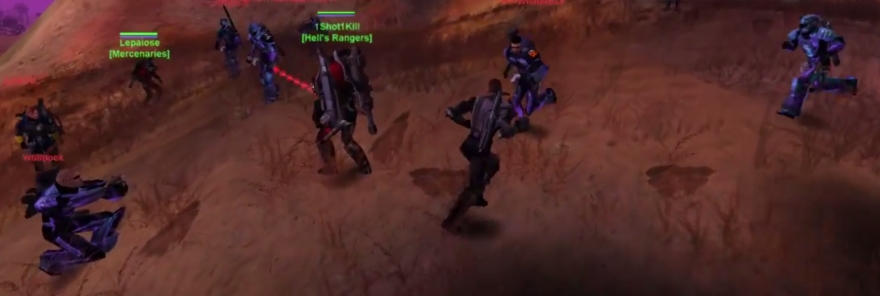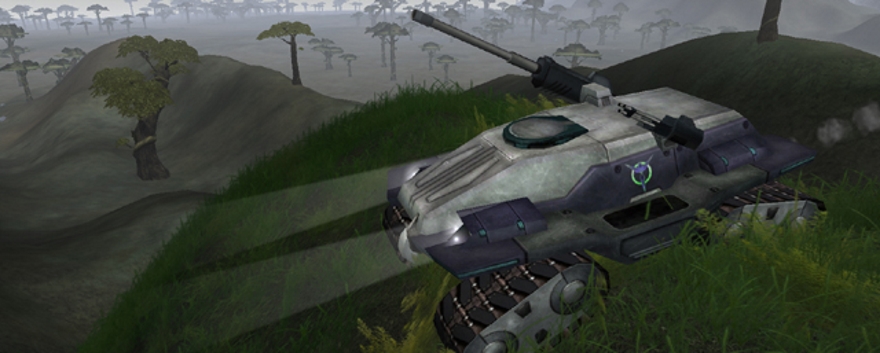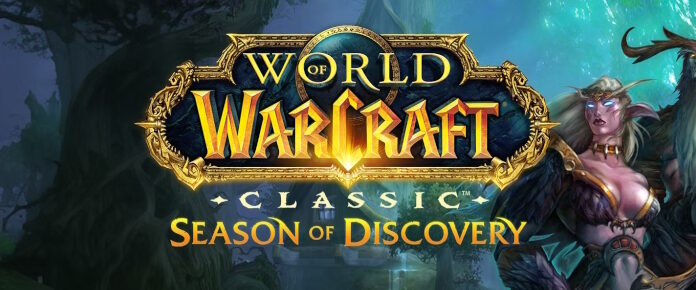
Unlike fantasy, the sci-fi genre has had a rocky relationship with MMORPGs. While studios have tried just as hard to make and promote them, there seems to be a curse that hovers over some of these games. From the canceled (Earth & Beyond, The Matrix Online, Tabula Rasa) to the radically retinkered (Star Wars Galaxies) to the relatively niche (Anarchy Online), sci-fi has struggled to be seen as relevant and embraced as its bigger brother.
That isn’t to say that these games or the genre is worthless, just that it’s a harder sell in many areas of entertainment. Fortunately, studios haven’t given up on these games, and some of these titles — such as EVE Online or Star Trek Online — have proven that they’re worth pursuing.
Enter PlanetSide, circa 2003. While sci-fi MMOs, multi-faction PvP, and online shooters had been done separately at that point, PlanetSide stepped up to the plate to combine all three into a persistent war on an alien planet. Today we’ll be setting our sights to the far reaches of the galaxy and beyond as we explore one of the more unique MMOs in existence.
 Pioneering first-person shooter MMOs
Pioneering first-person shooter MMOs
With online gaming technology in its relative infancy and high latency a limitation for the development of many MMOs, it was amazing that PlanetSide not only pulled off a fast-paced, real-time combat game on the scale it did, but that it also made it work well back in 2003. While World War II Online had FPS action like this in 2001, bugs and slow gameplay kept it from being as good — or as popular — as PlanetSide.
That’s not to say that PlanetSide was smooth as silk from the get-go. In recalling the history of this title, John Hewitt wrote, “They did deliver a unique product — a massive, seamless world with massive player numbers and a persistent battlefield — but the shooting mechanics were also a bit clunky, and the subscriber fee proved to be a turn-off for many players. It didn’t help that the graphics were rather mediocre, and that it was saddled with some early technical issues that made massive battles often an exercise in laggy frustration.”
In any case, many recent titles like all owe a debt of gratitude to PlanetSide’s pioneering of this hybrid gameplay. So whenever you hear an MMO boasting these days about attaining the glory of “real-time combat,” feel free to sniff in derision and say, “Yeah, PlanetSide had that. In 2003. Welcome to the party, pal.” That’s how you make friends!
Three-sided warfare
There’s a school of MMO thought that says three factions is the ideal setup for a PvP MMO (see Dark Age of Camelot). PlanetSide featured a three-sided war as a cornerstone from the very beginning. Players were offered a choice to fight for the authoritarian Terran Republic, the rebellious New Conglomerate, or the alien-happy Vanu Sovereignty, and faction pride quickly blossomed in the playerbase.
Of course, these factions weren’t about to play nice together — how boring would that be? — which meant conflict, and lots of it. The planet Auraxis was a battleground from day one of the launch, and players haven’t stopped fighting over its territory or prizes ever since.
If you ask PlanetSide fans, one of the greatest appeals of the game is this massive, ever-changing warfront. The game was not hacked up into tiny parcels of PvP instances but left open for a truly epic conflict of armies (it helped that there were no distractions from PvE mobs). At any given moment and position, hundreds of players could descend upon a valuable objective to fight for its control, throwing the landscape into glorious chaos. It wasn’t a small, contained experience but a wild and woolly morass of laser blasts and rocket explosions.
Skill > stats
While stats, gear and ranks all play their part in PlanetSide’s combat system, SOE designed the game to give everyone a fighting chance. Forcing players to fight in a first-person perspective (rather than the traditional third-person view that most MMOs use) kept the fights more immersive and skill-based than they would be otherwise.
Gaining more experience usually meant gaining access to a wider range of weapons and tools than a newbie — although a newbie had just as much of a chance at taking someone’s head off as a long-term veteran.
Instead of forcing players to conform to rigidly defined classes, PlanetSide let each user choose for himself how he wanted his character to evolve. Points could be invested into various specialties from weapons (hm, chaingun or sniper rifle?) to armor (bulkier armor for protection or suits with bonus weapons for offense?) to useful support skills (cloaking or healing?).
As each player invested more time and effort in the game, he or she was eventually able to find a niche role that was perfectly matched to the user. Because of this, there’s more of a “unique snowflake” feeling to characters, even if thousands of others may be able to do the same thing if they so choose.
By ground or by air
By gaining enough certification points, players were allowed to stop hoofing it and jump into one of the dozens of advanced vehicles that the game boasted. After all, this was the future of warfare, so why shouldn’t vehicles play a part? From giant mechs to airplanes to everything in between, vehicles play a crucial part of the battles. Given a choice between slowly running to a combat zone or jumping on board a transport, most everyone agreed that it was better to ride in style.
Vehicles had another effect on the game — they encouraged teamwork and grouping. In the big battles that PlanetSide routinely hosted, an isolated tank driver was just as dead as a foot soldier because there was always a counter out there to whatever you were using. Together, however, a character or vehicle’s weakness could be covered by the strengths of one’s teammates, allowing for coordinated attacks that hit from above and below.
Sequelitis
Although PlanetSide never — to my knowledge — hit six-digit subscriber numbers, it performed solidly enough for SOE to keep it running long past the expiration dates for many of its other older titles. Still in love with the concept and in full ownership of the IP, SOE began work on a sequel in the 2009 tentatively titled PlanetSide Next. About the same time, the original game merged its final two servers into one.
PlanetSide 2 came out in 2012 for the PC, practically rendering its ancestor obsolete overnight. With improved graphics, controls, and pretty much everything else, there was little reason other than loyalty or nostalgia for the PlanetSide 1 population not to make the switch. Even with a full sequel substitute available, SOE (later Daybreak) kept the lights on for several years afterward.
Unfortunately, the writing was on the wall for ol’ PlanetSide, and in June of 2016, Daybreak gave the order to quietly turn off the server. It was a weak end to one of the studio’s longest-running titles, a 13-year MMOFPS that kept the fight waging right up to the its final moments.
Have a favorite memory of PlanetSide to share? Add it to the history books by jotting it in the comments below!
 Believe it or not, MMOs did exist prior to World of Warcraft! Every two weeks, The Game Archaeologist looks back at classic online games and their history to learn a thing or two about where the industry came from… and where it might be heading.
Believe it or not, MMOs did exist prior to World of Warcraft! Every two weeks, The Game Archaeologist looks back at classic online games and their history to learn a thing or two about where the industry came from… and where it might be heading.














